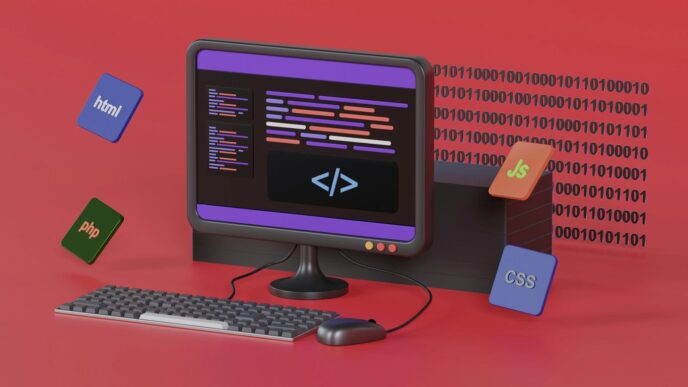If you’re looking to boost your Python development skills, PyCharm is a fantastic tool to help you do just that. This guide will walk you through everything from setting up the software to writing and debugging your code. Whether you’re a beginner or just need a refresher, you’ll find useful tips to make your coding experience smoother and more productive. Let’s jump right in!
Key Takeaways
- Installing PyCharm is the first step to start coding in Python.
- Utilize code completion features to speed up your coding process.
- Debugging tools in PyCharm make it easier to find and fix issues in your code.
- Integrating version control helps manage your code changes effectively.
- Explore plugins to enhance your PyCharm experience and add new functionalities.
Getting Started with PyCharm
So, you’re ready to jump into PyCharm? Awesome! It’s a fantastic IDE, and getting it set up is pretty straightforward. Let’s walk through the initial steps.
Installing PyCharm
First things first, you need to download PyCharm. Head over to the JetBrains website and grab the installer for your operating system. You’ll notice there are two main versions: Community and Professional. The Community edition is free and perfect for basic Python development. The Professional version has more bells and whistles, like support for web frameworks such as Django and Flask, but it requires a paid license. For most beginners, the Community edition is the way to go. Once downloaded, run the installer. The installation process is pretty standard – just follow the prompts. On Windows, you might want to add PyCharm to your PATH environment variable so you can easily launch it from the command line. On macOS, simply drag the application to your Applications folder. I personally prefer using the JetBrains Toolbox App. After installing, launch the app and accept the user agreement. Under the Tools tab, you’ll see a list of available products. Find PyCharm Community there and click Install.
Configuring Your Environment
Once PyCharm is installed, it’s time to configure your environment. When you first launch PyCharm, it will ask if you want to import settings from a previous installation. If this is your first time using PyCharm, choose "Do not import settings." Next, you’ll be prompted to select a keymap scheme. The default is usually fine. Then, you can choose your UI theme – either Darcula (dark) or a light theme. Pick whichever you prefer. You can always change it later in the settings. One of the most important steps is configuring your Python interpreter. PyCharm needs to know where your Python installation is located. You can either use an existing interpreter or create a new virtual environment. Virtual environments are highly recommended because they isolate your project’s dependencies. To create a new virtual environment, go to File > Settings > Project: [Your Project Name] > Python Interpreter. Click the gear icon and select "Add…" Choose "New environment" and select your base interpreter. Give your environment a name and click OK. This ensures that your project has its own set of packages, preventing conflicts with other projects.
Creating Your First Project
Now that PyCharm is installed and configured, let’s create your first project. On the welcome screen, click "Create New Project." Choose a location for your project and give it a name. PyCharm will automatically create a project directory for you. Make sure the correct Python interpreter is selected for your project. You can also choose to create a main.py file with some basic code. Once the project is created, you’ll see the PyCharm interface. The project structure is displayed in the Project tool window on the left. You can now start adding files and writing code. To create a new Python file, right-click on your project in the Project tool window, select New > Python File, and give it a name. You’re now ready to start coding! PyCharm offers a ton of features to help you write code more efficiently, such as coding assistance, code completion, and error highlighting. Have fun exploring!
Writing Code in PyCharm
Okay, so you’ve got PyCharm installed and a project set up. Now comes the fun part: actually writing some code! PyCharm has a bunch of features that make coding smoother, faster, and less prone to errors. It’s like having a coding assistant that’s always got your back. Let’s get into it.
Code Completion Features
PyCharm’s code completion is seriously impressive. As you type, it suggests possible completions based on the context. This isn’t just about finishing words; it understands your project’s structure, the libraries you’re using, and even the types of variables you’re working with. It’s a huge time-saver, and it helps you avoid typos and remember function names. I remember when I first started using it, I was blown away by how much faster I could code. It’s like it reads your mind (almost!).
- Basic Completion: Suggests names of classes, methods, variables, and keywords.
- Smart Completion: Filters the list to show only types that are expected in the current context.
- Statement Completion: Automatically completes code constructs like
if,for,whilestatements.
Using the Editor Effectively
PyCharm’s editor is more than just a place to type code. It’s packed with features that help you navigate, understand, and manipulate your code. For example, you can use code folding to collapse sections of code that you’re not currently working on, making it easier to focus on the important parts. You can also use the editor’s built-in search and replace functionality to quickly find and modify code throughout your project. And don’t forget about the editor’s support for multiple cursors, which lets you make the same changes in multiple places at once. It’s a real game-changer when you need to refactor code or make repetitive edits. I find the multiple cursors feature especially useful when renaming variables across a file.
- Code Folding: Collapse and expand code blocks.
- Multiple Cursors: Edit multiple lines simultaneously.
- Find and Replace: Search and modify code quickly.
Refactoring Code
Refactoring is the process of improving the structure of your code without changing its behavior. PyCharm has a bunch of refactoring tools that make this process easier and safer. For example, you can use the "Rename" refactoring to rename a variable or function throughout your project, and PyCharm will automatically update all references to that variable or function. You can also use the "Extract Method" refactoring to take a block of code and turn it into a separate function. This can make your code more modular and easier to understand. PyCharm’s refactoring tools are a lifesaver when you need to clean up your code or make it more maintainable. I once used the "Extract Method" refactoring to break up a huge function into smaller, more manageable pieces, and it made the code so much easier to read and understand. It’s like giving your code a makeover!
| Refactoring Tool | Description
Running and Debugging in PyCharm
So, you’ve written some code, and now you want to, you know, run it. And maybe, just maybe, it doesn’t work perfectly the first time (shocking, I know!). That’s where PyCharm’s running and debugging tools come in super handy. Let’s walk through it.
Running Your Code
Running your code in PyCharm is pretty straightforward. There are a few ways to do it, depending on what you’re trying to accomplish. The easiest way is usually just right-clicking in the editor and selecting "Run." But there’s more to it than that. PyCharm uses something called run/debug configurations startup properties to manage how your code is executed. These configurations let you specify things like:
- The script to run
- Command-line arguments
- Environment variables
- Python interpreter to use
You can create and modify these configurations in the "Run/Debug Configurations" dialog (Run -> Edit Configurations). This is especially useful when you have different ways you want to run your code, like with different sets of arguments or using a different Python environment.
Setting Breakpoints
Okay, so your code is running, but it’s not doing what you expect. Time to debug! The first step is setting breakpoints. Breakpoints are like little flags that tell PyCharm to pause execution at a specific line of code. To set a breakpoint, just click in the gutter (the space to the left of the line numbers) next to the line where you want to pause. A little red dot will appear. You can have as many breakpoints as you want. I usually start with one or two and add more as I figure out where the problem might be.
Using the Debugger
Once you’ve set your breakpoints, run your code in debug mode (Run -> Debug). When PyCharm hits a breakpoint, it will pause execution and open the debugger window. The debugger window shows you a ton of useful information, like:
- The current values of variables
- The call stack (the sequence of function calls that led to the current line of code)
- The output of your program
You can then step through your code line by line using the debugger controls:
- Step Over: Executes the current line and moves to the next line in the same function.
- Step Into: If the current line is a function call, it will jump into that function.
- Step Out: Finishes executing the current function and returns to the calling function.
- Resume: Continues execution until the next breakpoint or the end of the program.
I find the "Step Into" and "Step Over" options the most useful. Stepping through the code lets you see exactly what’s happening at each step and identify where things are going wrong. Debugging can be a bit tedious, but it’s an essential skill for any programmer. With PyCharm’s debugger, it’s a lot less painful than it could be!
Testing Your Code in PyCharm
Okay, so you’ve written some Python code in PyCharm. Great! But how do you know it actually works? That’s where testing comes in. PyCharm has some pretty cool features to help you write and run tests, so let’s check them out.
Creating Unit Tests
So, first things first, you need to create some tests. PyCharm makes this surprisingly easy. Let’s say you have a calculator.py file with some functions. You can right-click on the file (or even a specific function) and choose "Go To" -> "Test". PyCharm will then ask if you want to create a new test. If you say yes, it’ll generate a test_calculator.py file with some basic test stubs. It’s like magic, but with code. You can also use the shortcut <kbd class="key-shift">Shift</kbd><span>+</span><kbd class="key-command">Cmd</kbd><span>+</span><kbd class="key-t">T</kbd> on Mac or <kbd class="key-control">Ctrl</kbd><span>+</span><kbd class="key-shift">Shift</kbd><span>+</span><kbd class="key-t">T</kbd> on Windows or Linux.
Now, you need to fill in the test functions with actual assertions. This is where you check if your code does what it’s supposed to do. For example:
import unittest
from calculator import add
class TestCalculator(unittest.TestCase):
def test_add(self):
self.assertEqual(add(2, 3), 5)
This test checks if the add function from calculator.py returns 5 when you pass in 2 and 3. Pretty straightforward, right?
Running Tests
Alright, you’ve got your tests written. Now it’s time to run them! PyCharm has a built-in test runner that makes this a breeze. Just right-click on your test file and choose "Run". You’ll see a window pop up showing the results of your tests. Green means pass, red means fail. It’s like a traffic light for your code. PyCharm supports various testing frameworks, with unittest being the default. You can switch to others like pytest in the settings.
Interpreting Test Results
So, you ran your tests, and some of them failed. Don’t panic! PyCharm gives you some tools to figure out what went wrong. You can click on a failed test to see the traceback, which shows you exactly where the test failed and why. This is super helpful for debugging. You can also re-run individual tests or all the tests in a file. It’s all about finding those bugs and squashing them!
Here’s a quick rundown of what you might see in the test results:
- Passed: The test did what it was supposed to do.
- Failed: The test didn’t do what it was supposed to do.
- Error: Something went wrong while running the test (like an exception).
- Skipped: The test was skipped (maybe it depends on something that’s not available).
PyCharm also lets you configure test configurations to manage how your tests are run. You can specify which tests to run, which Python interpreter to use, and other options. It’s all about making your testing workflow as smooth as possible.
Version Control Integration in PyCharm
Version control systems (VCS) are super important for modern software development. PyCharm gets this, which is why it plays nice with a bunch of popular systems like Git, Mercurial, Perforce, and Subversion. I mostly use Git, so I’ll focus on that for these examples.
Configuring Version Control Systems
Alright, so first things first, you gotta enable VCS integration. Go to VCS -> VCS Operations Popup… from the top menu, or just hit Ctrl+V on Mac or Alt+`` on Windows/Linux. Then, pick your poison (Git, in this case) from the dropdown and hit OK. If you're opening a project that already uses version control, PyCharm should automatically detect and enable it. Now, when you go back to the VCS Operations Popup…, you'll see options for git add, git stash, git branch, git commit, git push, and a whole lot more. If you can't find what you need there, check the top menu under VCS->Git` – you can even create and view pull requests there.
Committing Changes
Committing changes is something I do all the time. When you’re ready to commit, go to VCS -> VCS Operations Popup… -> Commit…, or press Cmd+K on Mac or Ctrl+K on Windows/Linux. A window pops up where you can:
- Pick which files to commit.
- Write your commit message.
- Run all sorts of checks and cleanup before committing.
- See the difference in changes.
- Commit and push all at once by clicking the arrow next to the
Commitbutton and choosingCommit and Push….
It feels almost magical, especially if you’re used to doing everything manually on the command line. PyCharm’s integration really speeds things up.
Resolving Conflicts
When you’re working in a team, merge conflicts are bound to happen. If someone commits changes to a file you’re also working on, and those changes overlap with yours, the VCS can’t automatically figure out which changes to keep. That’s when you need to resolve the conflict. PyCharm has a pretty neat tool for this. It shows you the conflicting lines side-by-side, and you can choose which changes to accept or reject. It looks something like this:
| Line Number | Your Changes | Their Changes |
|---|---|---|
| 15 | Keep mine | Use theirs |
| 22 | Use mine | Keep theirs |
There’s a lot more you can do with version control in PyCharm. It’s worth digging into the documentation to see all the features it offers.
Enhancing PyCharm with Plugins
PyCharm is pretty great right out of the box, but you can really make it sing by adding plugins. Think of them as little add-ons that give PyCharm extra powers. They can do everything from supporting new languages to making your workflow smoother. It’s like giving your IDE a serious upgrade.
Finding and Installing Plugins
So, how do you actually get these plugins? It’s super easy. Just go to your PyCharm settings (Preferences on a Mac, Settings on Windows/Linux) and look for the "Plugins" section. You’ll see a "Marketplace" tab where you can browse all sorts of plugins. Just search for what you need, click "Install," and you’re good to go. PyCharm will handle the rest. You can even develop your own plugin if you can’t find what you need.
Popular Plugins for Python Development
There are tons of plugins out there, but some are real standouts for Python devs. Here are a few that I find myself using all the time:
- IdeaVim: If you’re a Vim user, this one’s a game-changer. It brings Vim’s editing mode right into PyCharm. Best of both worlds!
- Material Theme UI: Want to give PyCharm a fresh look? This plugin changes the whole interface to a Material Design theme. It’s all about aesthetics, right?
- .ignore: This helps you manage your
.gitignorefiles, making sure you don’t accidentally commit files you shouldn’t. Super handy for keeping your repos clean. - Markdown: If you work with Markdown files (like READMEs), this plugin gives you a live preview so you can see how your documents will look. No more guessing!
Managing Plugin Settings
Once you’ve got a bunch of plugins installed, you’ll probably want to tweak their settings. Each plugin usually has its own configuration options. You can find these in the same "Plugins" section of the settings. Just click on the installed plugin and look for a "Settings" or "Configure" button. From there, you can customize how the plugin works to fit your workflow. It’s all about making PyCharm work for you, not the other way around. You can also add external tools to PyCharm. For example, you can add Flake8 code analyzer to your IDE.
Exploring PyCharm Professional Features

Okay, so you’ve been using PyCharm, maybe even for a while. But have you peeked under the hood of the Professional version? It’s got some seriously cool stuff that can make your life as a developer way easier. Let’s check it out.
Django Support
If you’re into web development with Python, you’ve probably heard of Django. It’s a big deal. PyCharm Professional has amazing Django support built right in. I mean, it’s not just syntax highlighting; it’s like having a Django expert sitting next to you. You get code completion, navigation, and even special tools for managing your Django projects. Setting it up is pretty straightforward too. You just go into your settings, find the Django section, and enable support. Boom! You’re ready to roll.
Database Tools
Dealing with databases can be a pain, right? Well, PyCharm Professional includes a bunch of database tools that make it less of a headache. You can connect to pretty much any database you can think of – MySQL, PostgreSQL, you name it. Then, you can browse your data, run queries, and even design your database schema, all from inside PyCharm. It’s super handy for when you need to tweak your data or figure out why something isn’t working. It’s a real time-saver, trust me. You can easily manage your database schema directly within the IDE.
Scientific Mode
Now, if you’re more into data science or scientific computing, PyCharm Professional has something special for you: Scientific Mode. This mode gives you a bunch of tools that are perfect for working with data. Think things like:
- Interactive plots: Visualize your data right in the IDE.
- Array viewers: Inspect your arrays and matrices easily.
- Console integration: Work with IPython and Jupyter notebooks seamlessly.
It’s like having a mini data science lab right inside your IDE. It makes exploring data and running experiments way more convenient. Plus, the integration with Jupyter Notebook is a game-changer. You can run and debug your notebooks directly from PyCharm, which is awesome. If you’re doing any kind of data analysis, this is a must-have. You can get a free Pro features trial to test it out.
Wrapping It Up
So there you have it! PyCharm is a solid choice for anyone getting into Python development. It makes a lot of the boring stuff easier, so you can focus on writing great code. We’ve covered a bunch of topics, from installing PyCharm to using its cool features like debugging and version control. If you have questions or want to share your own tips, drop a comment below. Happy coding!
Frequently Asked Questions
What is PyCharm?
PyCharm is a special program called an Integrated Development Environment (IDE) that helps you write and manage Python code easily.
How do I install PyCharm?
You can download PyCharm from the JetBrains website. Just follow the instructions to install it on your computer.
Can I use PyCharm for free?
Yes! There is a free version called PyCharm Community Edition that you can use for basic Python programming.
What are plugins in PyCharm?
Plugins are extra tools you can add to PyCharm to make it even more powerful. They can help with different tasks or add new features.
How do I debug my code in PyCharm?
You can debug your code by setting breakpoints and using the built-in debugger. This lets you step through your code to find errors.
Does PyCharm support web development?
Yes, the Professional version of PyCharm has features that support web development, including frameworks like Django.














